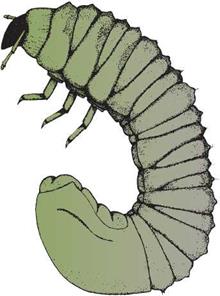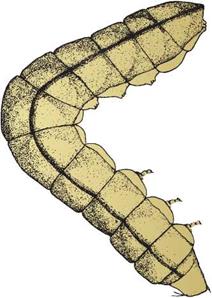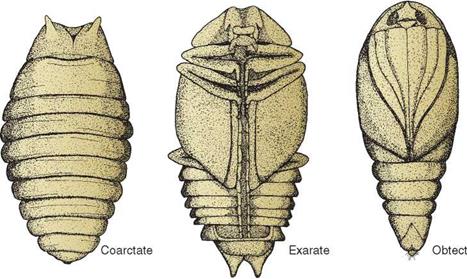No members of the animal kingdom transform more dramatically during their development than insects. The homely caterpillar becomes the graceful butterfly; the grub worm in last summer’s lawn becomes the June bug buzzing around the porch light this year. The changes in insect form as they grow are termed metamorphosis. Some insects have no metamorphosis, going from the earliest stage to the adult form looking the same except for increasing size. Others have complete metamorphosis and include four stages of development: egg, larva, pupa, and adult. Still other insects have some form of metamorphosis that includes a nymph stage but not the larva or pupa stages. They are said to possess gradual or incomplete metamorphosis.
In those insects with a nymph stage, the young insect usually bears some resemblance to the adult into which it will develop. At first the resemblance may be slight, but as the insect grows, it passes through a series of growth stages called instars. As it grows, the insect must shed its confining exoskeleton (molt) to permit continued growth into the next instar stage. Each molt and new instar brings the insect closer to the adult form.
An insect’s life begins as an egg. The eggs may hatch inside the female (and are termed ovoviviparous) or they may be laid by the female in large or small clusters for later hatching (oviparous). The eggs are usually deposited near a food supply since the insects that hatch can move only short distances but possess insatiable appetites. The female insect may lay as few as one egg or as many as several thousand daily, depending on the species. There is little evidence of a maternal instinct among insects; once the eggs are laid, the female leaves them to hatch and fend for themselves.
Most insects undergo a complete metamorphosis, including the larva and pupa forms. The larval stage finds the insect in a worm-like form and possessing a chewing mouthpart (Figure 6-5). In this form, the insect does little more than eat and grow. Much of the economic devastation


|

figure 6-5. Types of insect larvae (Courtesy Cari Goetcheus)
|
figure 6-6. Three types of insect pupae (Courtesy Cari Goetcheus) |
wrought by insects against crops results from this larval stage. When larval maturity is reached, the larva ceases feeding and seeks a protected location for its next stage of growth, the pupal stage.
The pupa is totally helpless and physically inactive (Figure 6-6). However, while in this stage, the insect undergoes remarkable alterations in its physiology and morphology. It is during the pupal stage that the transformation from worm-like larva to adult occurs. Legless forms develop legs, wings develop where none were, mouthparts change from chewing to another type. The miracle of metamorphosis is one of the true wonders of the natural world (Figure 6-7).
Whatever the type of metamorphosis, the adult stage is eventually reached. The most essential function of the adult insect is reproduction. Some insects die soon after mating or laying eggs. Other insects live for a long time in the adult stage. The majority of insects are of greatest economic significance in their nonadult stages, since that is when the greatest feeding and crop destruction occurs.




